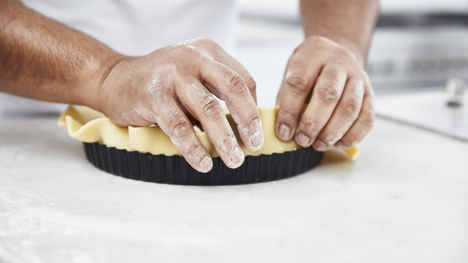Once you’ve made your lovely homemade pastry, the last thing you want to do is for it to tear or crumple as you try and get it into your tart tin. By following our key steps you can become confident in this baking task, as well as learning what to do when it goes wrong. Then take your skills on and make a special tart from our collection
How to line a tart tin with pastry?
You ideally want to use a loose-bottomed, metal tart tin, for ease of release. Then roll your pastry out to a circle that is large enough to cover the base of your tin and the sides with some overhang at the top. Drape the pastry over your rolling pin then gently lay it over your tart tin and gently encourage it into the base and sides. You want to get the pastry right into the edges and fluting as any gaps might mean the sides will collapse. Rather than using your fingers, which can stretch and tear the dough, take a small piece of pastry from an extra corner, roll into a ball and use it to press the pastry into the edges. Then roll a rolling pin over the top to trim. Follow our method below for the best results:
Make your shortcrust pastry following our recipe
Scatter a light dusting of flour on your work surface, remove the pastry from the fridge and roll out to a thickness of 3-4mm, rotating regularly to ensure it is evenly rolled
Trim the pastry into a disc slightly larger than the tart tin
Spray your tart tin with baking spray, then very lightly dust with an even layer of flour
Pick up the pastry (using a rolling pin if the pastry is a bit delicate) and drape over the tart tin. Gently mould the pastry into the tin
Roll some of the pastry trimmings into a ball and use this to gently press around the edges of the tart base, pushing it into the sides and fluting evenly. Make sure the pastry is flush against the case all the way around
Run a knife around the edge of the tart tin to cut away any excess pastry with a knife or by rolling a rolling pin over the top of the tin. Place in the fridge for at least 1 hour to chill before baking
How do I fix tears or folds in my pastry?
If your pastry does crack or tear, don’t worry; it may feel like a disaster, but patching up a tart case is fairly easy and you will barely notice the fix once it’s baked. Simply press a very small amount of leftover pastry into any gaps and gently smooth so it is the same thickness as the rest of the dough. If you notice any gaps once you have blind baked your case you can also use the raw dough to patch up any holes at this stage, just returning the case to the oven for another 5-10 minutes to cook the raw pastry without colouring it.
How do I stop my tart case from leaking?
You want your pastry tart case to be watertight, especially if it is going to hold a very wet filling. Adding a layer of beaten egg white to your blind baked case, brushed lightly over, will create a seal. Just return the pastry case to the oven for 3-4 minutes to set it before proceeding with your recipe.
How do I stop my pastry from shrinking in the tart tin?
A few things can cause your pastry to shrink. One is uneven rolling, or stretching the dough, and the other is not getting the dough right into the corners of the tin. Follow the method above, gently easing the pastry into the tin and pressing using a dough ball right into the sides in order to avoid this.
When do I blind bake my tart case?
Once you've lined your tart tin with your rolled out dough, it's time to blind-bake. View our how to blind-bake guide for how to do this. And then put your new skills to use with a showstopping recipe such as Theo Randall’s Amalfi lemon tart or Shay Cooper’s luxurious recipe.
Get in touch
Please sign in or register to send a comment to Great British Chefs.

